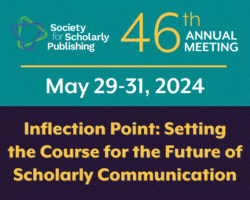By Bill Kasdorf, VP, Apex—This year’s book-oriented O’Reilly Tools of Change (TOC) conference, held in New York City February 9-11, was a something of a watershed in the transition from the aspirational to the actual when it comes to digital publishing. In past years, TOC was mostly about what books might be, or could be, or should be, in the digital era. This year, it was mostly about what they are.
As scholarly publishers know, most of the digital transformation of our business has been on the journal side so far. Where there have been exciting and admirable experiments, and some actual accomplishments, on the book side, most discussions of digital books in the past have either focused on the too-simple or the too-complex. It has been easy to dismiss e-books as being mostly romance novels and science fiction, or to shrug off multimedia or participatory “born-digital” books as exercises in impractical pyrotechnics.
E-Books are Here, Now, for All Kinds of Books
The clear message from TOC 2009: don’t let yourself get trapped in the old paradigms. True, in the area of trade books, e-books are still a tiny portion of sales; but their growth is in the triple digits, and what is most interesting, sales of e-books tend to mirror sales of print books now—the bestselling e-books are the same titles as the bestselling print books. In STM, estimates of digital revenue range from 15-30% of total book revenue; in higher ed it’s up to 30%; and in reference it’s 60%.
These statistics are from “E-Books: Business Models and Strategies,” one of the outstanding tutorials that started off the conference this year, many of which (including that one) sold out. In another departure from the past, when discussions of e-books were often confined to simple trade books, this tutorial provided a comprehensive, systematic survey that compared and contrasted trade books, textbooks, reference books, and STM.
The New Kindle 2 . . .
It seemed somehow appropriate that right in the middle of that tutorial, only a few blocks away, Amazon was announcing the new Kindle 2 at the Morgan Library. It was evident throughout all of TOC that the start-and-stop history of e-book devices is over, and that Amazon’s Kindle and Sony’s eReader have finally established a beachhead that will hold.
. . . was Out-Buzzed by Stanza
But if you thought the buzz at TOC would be about the new Kindle, think again. Instead, it wasn’t about a dedicated e-book device at all. The really big e-book buzz was about Stanza, the free e-book reading software for the iPhone. Its adoption has been phenomenal. In his Wednesday keynote, Neelan Choksi, COO of Lexcycle (maker of Stanza), noted that there are already 1.3 million Stanza users in 60 countries who have downloaded over five million e-books; of the 100,000 titles already available on Stanza, half of them are free and half are for sale. In fact, in his keynote he made the announcement that Stanza will now support Adobe’s DRM, to enable publishers who choose to protect their content to do so.
The D Word: DRM
Not that he was advocating that they do so. Although nobody was heard referring to DRM (Digital Rights Management) as “the D word,” they might well have. Cory Doctorow, in his Tuesday keynote, provided a particularly eloquent and entertaining rant about DRM. His key point was that the e-book vendors—particularly Sony and Amazon (with both the Kindle for e-books and Audible for audio books)—appear to be protecting publishers but are actually locking in publishers with their proprietary DRM schemes, quickly moving to dominate the market and making it impossible for readers to move their e-books onto other platforms.
In his view, vendors should not be dictating DRM to rightsholders. It should be the publisher’s choice. And it was clear that he (as well as most of the rest of the speakers) thought the choice should be clear: no DRM. (That initial e-book tutorial, though, made it very clear that this issue is quite different for higher-ed and reference publishers than it is for trade or STM publishers.)
Everybody, It Seems, Loves EPUB
One other clear watershed: it is evident that the IDPF’s release of the EPUB XML model for e-books is establishing a clear standard. Speaker after speaker—from Marisa DeMeglio of the accessibility-focused DAISY consortium, who showed the “Save as DAISY” add-on for Microsoft Word and the DAISY Pipeline for transforms, to Bill McCoy from Adobe, who showed how thoroughly Adobe is embracing EPUB as a complement to PDF—confirmed that EPUB is here to stay.
In fact, McCoy made a number of important announcements in the course of his talk: in addition to the expanded EPUB support in InDesign CS4, Adobe is creating a rich collaborative online environment for EPUB authoring called Adobe Buzzword; they are committed to working on an Acrobat EPUB output from PDF; they are actively working with third party software developers to encourage them to develop EPUB export capability (for example, Aspose.Words, the data conversion software Adobe uses for the EPUB export feature in Buzzword); and they committed to providing an open-source Java library called EPUBGen.
See It Here First . . .
TOC is not only a venue for important announcements like Adobe’s or Lexcycle’s, it is also where new gadgets are often unveiled. The two this year were interestingly complementary.
The hottest item was the Plastic Logic e-reader. This is a super-slim, super-slick, super-simple, E-Ink-based, letter-sized device that, ironically, was not originally designed as an e-book reader. Instead, it is mainly designed for reading newspapers, magazines, and business documents. Yes, it’s EPUB-based; you can also view PDFs, Word files, Excel files, PowerPoints, and HTML files on it. It’s wireless; it has a touch screen; and it enables full annotation. It’s about the size and weight of a legal pad that you’ve already torn off most of the sheets from. It’s hoped that you’ll be able to see this beauty at the session on e-books and handhelds at the SSP Annual Meeting.
The exhibit floor also had a working model of the next-generation Espresso Book Machine 2, which, amid all the e-book buzz, creates good old print books, one-by-one, in about 7 minutes (the release version is expected to get that down to four minutes) at a cost of about a penny a page. Championed for years by the venerable Jason Epstein, a publishing innovator for many decades (he’s credited with creating the original trade paperback, for example—which is exactly what the EBM2 churns out), the EBM2 is designed not just to keep your local bookstore alive (by enabling you to buy a print book from their digital stock while you wait) but to make books available to developing nations as well. Epstein gave a thoughtful keynote on the history of books, and in contrast to most of the other speakers, he made the case for the solitary genius creating literary works and the need for DRM.
Books as Process, Not Product
Most of the other speakers, on the other hand, were not only anti-DRM, they drove home the point that increasingly, books are collaborative creations in ways they never were in the past. In his opening keynote, Bob Stein, from the Institute for the Future of the Book and one of the pioneers of digital publishing, discussed the evolution of his definition of a book from his ca. 1981 definition, “Books are what humans use to move ideas around in time and space,” to today’s: “A book is a place where readers (and sometimes authors) congregate.” He made a compelling case for the reader’s becoming more a peer of the author: “Authors become leaders of communities of inquiry (non-fiction) or creators of worlds that readers populate (fiction).” This “expands the content of a book to the process that leads up to it and the process that results from it.” The role of the publisher in the future is “to build and nurture vibrant communities for authors and their readers”—a message that will be especially resonant to many members of SSP.
Peter Brantley, Executive Director of the Digital Library Federation, provided an ideal confirmation and complement to Stein’s keynote. Beginning with I.A. Richards’ 1924 definition—“A book is a machine to think with”—he articulated how the massive, rapid shift from analog to digital has made books into “networked commodities” and transformed reading from a solitary act to a social act. Like Stein, he urged publishers to see their role as changing from the creation of products to the creation of services, and pointed out that in the long run these services will create renewable revenue.
Nick Bilton, from the R&D Lab at the New York Times, in pointing out how social networks have become the filters and aggregators of the massive amount of content we’re bombarded with, provided the startling statistic that he is presented with 162,000 links every day. The old model of the elites informing the people has been turned on its head: now, the emphasis is on the voice of the people informing the elites.
Jeff Jarvis, author of What Would Google Do?, also reinforced the message of books becoming more process than product; he pointed out that “we are switching from a content economy to a link economy.”
Sara Lloyd, Digital Director of Pan Macmillan, said that “content is king” is giving way to “comments are king.”
And Jason Fried, head of a 12-person Chicago software firm called 37Signals, told how he and his colleagues made half a million dollars by collecting their blogs into a self-published book, and then another half a million on spin-offs. It was clear that their lack of experience in publishing was more an advantage than an obstacle . . . though, interestingly, they have placed their second book with a real publisher.
Reasons To Be Excited
The final keynote, appropriately enough, was by Tim O’Reilly, founder of O’Reilly Media, who gave a truly inspirational talk that made clear that despite the fact that we live in a difficult time (or, arguably, because of it), this is really a wonderful time to be a publisher. Billions of people are coming out of poverty around the world and joining the world of ideas; we’re building a global intelligence network; people are reading—a lot; curation still matters; people do pay for access to information (he thinks e-books will be 50% of most publishers’ sales by 2011—at O’Reilly, they already are); mobile reading is taking off (their iPhone: The Missing Manual is a huge success); the Google Book Search Mobile App will be huge; and people need what we do.
It was nice to hear such optimism in the middle of the economic meltdown—and to have it backed up by real success stories. Finally, what in the past could seem like a head-in-the-clouds conference has matured into a feet-on-the-ground one.
Bill Kasdorf is Vice President of Apex Content Solutions and General Editor of The Columbia Guide to Digital Publishing.



Join the Conversation
You must be logged in to post a comment.